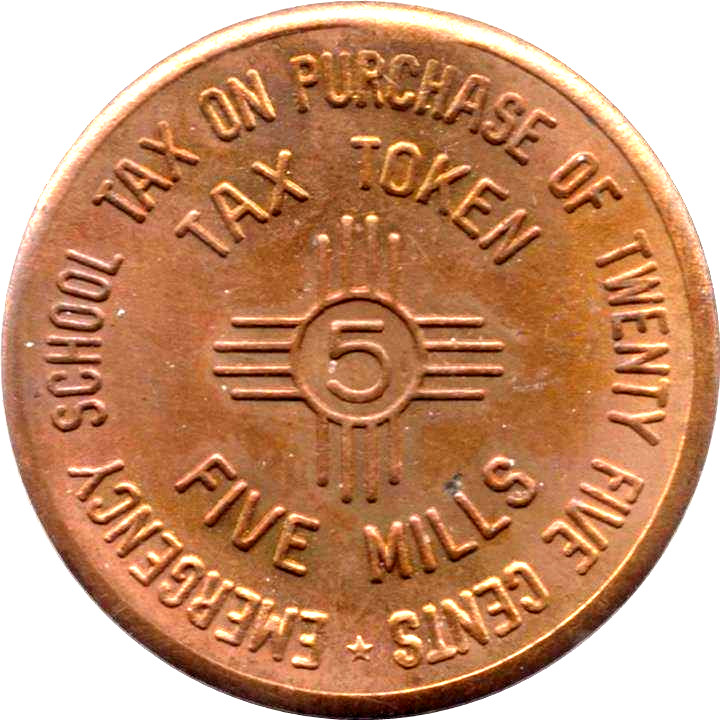A 1935 New Mexico tax token is one of the most valuable items in the world. The coin is valued at up to $100 and is a rarity, according to Numista. The token was minted with a protective sheath for 85 years and then placed into a modern protective coin case to protect it from tampering and other damage. The obverse of the token displays the coat of arms of the state of New Mexico. It shows an American Eagle with arrows and a Mexican Eagle with serpent, all perched on a scroll with the motto “Crescit Eundo.”
Before the sales tax was implemented, final prices were often in cents, causing many transactions to be inequitable. For example, a $1.25 item would actually cost $1.2875, a fraction of a cent. Rounding up to $1.29 would create a 3/4c profit and rounding down to $1.28 would make the sale more than twice as large as it was originally. To solve this problem, retailers began issuing tokens that were denominated in mills, one-tenth of a cent.
Sales tax was first implemented in 1905, and many items were priced in fractions of a cent. For example, a $1.25 item would cost $1.2875, which would be rounded up to $1.28 and 3/4c. This would lead to an unfair 1/4c profit or a 3/4c profit. To avoid such a situation, retailers began issuing tokens denominated in mills.
The introduction of a general sales tax in the United States was a major change in the economy. It largely eliminated the need to issue fractional cents and was replaced by a sales tax. In fact, the use of general sales tax in the United States was so low by 1914 that only two countries used it for national finance. Today, we have only two types of sales tax:
- The excise tax;
- The general sales.
New Mexico Sales Tax Tokens: 1935-1938

The New Mexico token was issued in 1935, and the state mint reissued them in several different materials. These sales tax tokens are made from a variety of different materials, including fiber, plastic, zinc, and bronze. There is also a 5 mills sales tax token that was released in 1938.
These sales tax tokens were introduced in the 1930s, but the idea behind them was not well understood. The sales tax tended to result in final prices that were fractions of cents. For instance, a $1.25 item with a 3% sales-tax would cost $1.2875, a quarter cent. If this were a quarter cent, then a penny would be one cent and three-quarter cents. This would be unfair, so the solution was to introduce tokens that were worth five mills, one tenth of a cent.
The tax token was also used by many other states in 1935. These sales tax tokens were made from a variety of materials and were issued in different denominations. A mill, in this case, was equivalent to one tenth of a cent, and it was the smallest denomination. The 5 mills issued in 1934 were the first to be legal in the US. These tokens were issued in various states and the United States embraced them.
Tax Tokens from the US State of Missouri: The Most Popular Examples
The tax tokens issued in the US state of Missouri in 1935 are the most popular examples. These tokens are made from a variety of materials, and have been used for decades. The value of one mill is equal to one tenth of a cent. The five mills are the most common form of the coin in the state of Missouri. It was a popular form of money in the US.
In 1935, the state of Missouri introduced tax tokens in their state. The tokens were made of wood, metal, and plastic. The mills were equal to a tenth of a cent. The use of these tokens was a great way to collect sales tax. The new laws helped the state become more competitive. And now, with every cent earned, it becomes easier to make purchases in the state.
The 1935 New Mexico tax token is the earliest known tax token in the United States. The green plastic token was released in the state and was used as a form of currency in the state. The treasury department regarded the tax token as a serious offense against US coinage, and they were forced to drop the legislation. However, the treasury department of the US refused to give up, and the laws were passed without a hitch.
The 1935 New Mexico tax token was made of various materials. The first token was made of fiber. Its mills were equal to one tenth of a cent. It was also used as a form of payment for fractional taxes on small purchases. It was a green plastic piece of currency and was released in the state of Missouri. Its face value is one-tenth of a cent.
The 1935 New Mexico tax token was released in the state of Missouri and is equivalent to 25 cents. It is made of plastic and shipped in a padded protective envelope. The paper currency was created in the same manner as the tax token. Its design has been very consistent, and its shape and color are very similar to a modern dollar. The three-mill Missouri state coin was the first to introduce a general sales tax in the country.

She is numismatist, crypto expert and have been active in the profession for over four decades. For nearly six years she was the market analyst and writer for CDN (Coin Dealer Newsletter: The Greysheet) She evaluated, edited and reported current market trends for all US coin and crypto tokens series. Presently She update various numismatic websites and author NGC’s (Numismatic Guaranty Corporation) Weekly Market Report.
